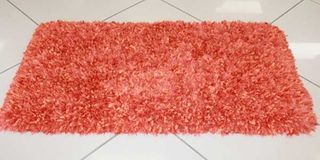There is a mat, rug or carpet for every room in your house

Mats come in a variety of sizes, designs and and materials and you can personalise them by having a message or logo embroidered on them. PHOTO | FILE
What you need to know:
- Floor coverings serve a variety of purposes. For instance, they ensure indoor safety by providing traction, thereby reducing the chances of falls. In addition, they trap dust particles and microbes stuck on footwear.
- Wool’s durability and elegance makes it a popular material for making floor coverings. “Since it is natural, wool contains no allergens, and is, therefore, the safest to use for mats and carpets.
- Wool is also easy to dye, which enables weavers to come up with creative colours and designs,” explains Ms Muthoni, adding that wool can also be blended with cotton to for increased turgidity.
Rugs, carpets and mats are floor coverings that have been used for many centuries.
In the olden days, animal hides were used to cover the floor. While Mongolians are believed to have been the first to weave rugs, it is the Persians who took up the art and refined it, hence the popularity of Persian carpets. In 1949, Russian archaeologist Sergei Rudenko excavated a rug in the Paryzyk Valley of Siberia, which was believed to be from the fifth century BC.
The discovery renewed interest in the origin of rugs among archaeologists.
Floor coverings serve a variety of purposes. For instance, they ensure indoor safety by providing traction, thereby reducing the chances of falls. In addition, they trap dust particles and microbes stuck on footwear.
Doormats are the first line of defence in keeping dust, mud and other dirt from entering the house. These mats, which also give the first impression of a house, are also exposed to the elements. Consequently, advises Jackline Owala of Isamado Homecare they should be made of durable material
Meanwhile, bath mats provide a smooth but non-slippery surface. They also help to absorb water, keeping the room relatively dry. “These types of mats usually have a sisal lining underneath to increase their grip against the floor to prevent dangerous slips,” says Carol Muthoni, who makes mats.
Rugs, carpets and mats can be made from tough, durable material such as coir (Coir is the loose fibre obtained from the leathery external shell of a coconut fruit), palmyra (palm) fibres and stalk, nylon, latex and even metals such as aluminium. But they can also be made from expensive fabrics such as silk, or cost-efficient textiles such as wool.
VERSATILE FABRICS
Silk is a natural, lustrous fibre with high tensile strength and is ideal for making Oriental rugs and mats. “The fibre is soft and makes comfyor mats and rugs. However, silk articles rare high maintenance. Silk mats and carpets are durable but sometimes costly due to the high cost of producing silk,” says Ms Owala, adding that silk can be combined with cotton to reinforce the weft.
To maintain silk rugs, Ms Owala says, both the upper surface and the underside should be cleaned using a soft brush, water and the recommended detergents. “Steam cleaning, hot water, abrasive detergents and a hard brush should be avoided as these damage silk,” she says.
Meanwhile, wool’s durability and elegance makes it a popular material for making floor coverings. “Since it is natural, wool contains no allergens, and is, therefore, the safest to use for mats and carpets. Wool is also easy to dye, which enables weavers to come up with creative colours and designs,” explains Ms Muthoni, adding that wool can also be blended with cotton to for increased turgidity.
“Woollen mats and carpets have a tendency to collect dirt and grime and thus need regular sweeping or the use of a high-power suction machine for cleaning and regular vacuum cleaning for maintenance,” says Ms Owala.
Mats and rugs can also be made from jute, a glossy, strong and coarse fibre made from the stem of the Indian herbaceous plant that grows in marshy areas.
“The downside of these mats is their low water-retention capacity. They disintegrate if immersed in water. To clean them, use a soft brush and a dab of water, then dry them completely,” advises Ms Owala..
Bamboo is one of the most versatile plants known, and it also comes in handy in making floor coverings. Bamboo is liked by interior décor experts due to its rustic and earthy characteristics.
Synthetic fibres are preferred for large-scale production of mats, carpets and rugs, with nylon being the most popular thanks to its durability, resilience and ease of maintenance.
“Nylon mats are the best for high-traffic areas such as offices, banking halls and shops. They are also cheaper compared with silk and wool,” says Ms Muthoni.
Other synthetic fibres include olefin, acrylic and polyester, all of which are less durable than nylon, but easier to maintain.
Carpets and mats in your home or office certainly do more than just cover the floor.
At home, they can reveal your personality while in the office, they can remind customers of who you are by having corporate messages embroidered on them.




